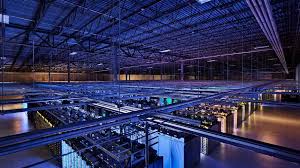In 2024, Google's data center energy consumption surged dramatically, reaching a staggering 308 million megawatt-hours — more than four times higher than the previous year. This sharp increase has put the tech giant under renewed scrutiny over its environmental impact, especially as it races to support the growing demand for artificial intelligence and cloud services.
The latest report, released by Google and corroborated by Indonesia’s Ministry of Communication and Informatics (Kominfo), highlights an energy consumption trend that could challenge global sustainability targets. As the world becomes increasingly data-reliant, the tech industry finds itself at the center of a climate debate, with Google’s energy practices now under the spotlight.
AI Infrastructure and the Surge in Energy Use
The primary driver behind this spike in consumption is the rapid expansion of AI infrastructure. Google has been aggressively investing in data centers capable of handling AI model training and deployment, particularly in Southeast Asia and North America. These systems require exponentially more computational power, and by extension, more energy.
According to internal figures, much of the energy was consumed by training large language models (LLMs) and supporting AI-driven products across Google Cloud, Search, and Workspace. As businesses and developers increasingly adopt generative AI tools, the load on Google's server infrastructure has multiplied.
In 2023, Google consumed around 75 million megawatt-hours. Just a year later, that number has ballooned to 308 million. The company has acknowledged the surge and pledged to maintain its goal of operating on carbon-free energy by 2030, but experts are skeptical about how realistic that commitment is given the current trajectory.
Regional Spotlight: Indonesia’s Role in Google's Expansion
Interestingly, Indonesia has emerged as a crucial hub in Google’s data center expansion strategy. With its booming digital economy and strategic geographic location, the country is now home to several cloud and edge computing facilities managed by Google Cloud.
However, Indonesian authorities have voiced concerns about the sustainability of large-scale data operations, particularly in regions where renewable energy is still underdeveloped. Kominfo has urged multinational tech firms to align their infrastructure plans with the nation's green energy roadmap, which emphasizes solar, hydro, and geothermal energy sources.
Google Indonesia has responded by announcing collaborations with local power providers and exploring green energy procurement mechanisms. Still, as demand grows, questions remain about how sustainable this growth can be without drastic improvements in grid efficiency and renewable adoption.
Energy Efficiency Vs. Climate Accountability
Google has long positioned itself as a leader in corporate sustainability, having operated on 100 percent renewable energy since 2017. However, there's a growing distinction between purchasing offsets and actual zero-emission operations. The 308 million megawatt-hours used in 2024 have called into question how effective these sustainability claims really are.
Environmental watchdogs argue that energy-efficient architecture alone is no longer sufficient. While Google's data centers are among the most optimized in the world in terms of power usage effectiveness (PUE), the sheer volume of energy being consumed risks negating these gains.
Google defends its strategy by emphasizing the long-term benefits of digital transformation. According to its public statement, "AI and digital services can reduce carbon emissions in other sectors such as agriculture, transport, and healthcare." Nevertheless, the irony remains — the technologies meant to help the planet are consuming unprecedented energy to function.
Global Implications and Tech Industry Trends
Google is not alone in this conundrum. Other tech giants like Microsoft, Amazon, and Meta are also reporting increasing data center power needs due to the AI boom. Microsoft, for instance, reported a 30 percent year-on-year energy increase in 2023 due to Azure's expansion.
This trend is forcing companies to rethink data center design, location, and operational models. There’s a growing interest in modular data centers, liquid cooling technologies, and hyperscale green zones — areas with abundant renewable energy.
Governments are also starting to step in. The European Union, for instance, is drafting legislation to mandate energy transparency for hyperscale data centers. If passed, companies like Google will be required to publish real-time energy use and emissions data by region, including water consumption and heat output.
Balancing Innovation and Environmental Responsibility
For Google, the challenge now is finding the right balance between technological innovation and environmental stewardship. The company cannot afford to slow down its AI ambitions, especially as competition intensifies globally. At the same time, public trust and regulatory goodwill hinge on meaningful climate action.
One promising area is carbon-aware computing, where workloads are scheduled during times when renewable energy is most abundant. Google has already implemented early versions of this in select regions, adjusting server loads based on solar and wind availability.
The company is also investing in direct renewable energy projects, such as solar farms and wind parks that feed directly into its data centers. These are more impactful than purchasing credits, but they require long-term planning and collaboration with governments.
Conclusion: The Energy Cost of a Digital Future
The quadrupling of Google's data center energy consumption is a wake-up call for the tech industry. As the demand for AI, cloud, and digital services grows, so too does the environmental cost of delivering those services. Google, as a leader in the space, has a responsibility to lead not just in innovation, but in sustainability.
While there are steps being taken — from carbon-aware scheduling to renewable power investments — the pace of energy growth threatens to outstrip green efforts. Without a global framework and accountability, these improvements may not be enough.
As we race toward an AI-powered future, one question remains clear: can technology save the planet without draining it in the process?
Read More






 Friday, 09-01-26
Friday, 09-01-26







